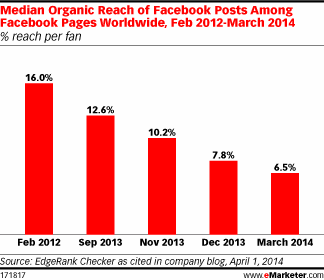Erik Qualman's Blog, page 603
April 22, 2014
Get Social for Better Fundraising Results

 Fundraising provides a financial way for students, parents and schools to get new sporting equipment, take a field trip, get updated computers in the classrooms and more.
Fundraising provides a financial way for students, parents and schools to get new sporting equipment, take a field trip, get updated computers in the classrooms and more.
It teaches students from a young age that when you want something, you have to work for it.
Fundraising also teaches children how to work in a team, how to sell in a competitive environment, how to get creative with their selling and advertising tactics, and it shows them that consistency and hard work get results.
With the increasing presence of social media, fundraising can be taken to a new level.
Examples of fundraising
Schools can put on many different types of fundraisers.
Examples include providing a service or selling a good (such as cookies or fruit), having a contest or raffle, or hosting some sort of event like a school carnival. You can have a spell-a-thon, a chili cook off or an auction. You can even host a bingo tournament. The options are endless.
How social media can be used
Thanks to social media, there really is no stopping how far kids can go to promote and sell their product or advertise their fundraising event.
You can post the fundraiser on your own personal social media pages and schools can post the events on their school pages.
Morgantown High School in West Virginia, for example, reached out to alumni and thousands of other people via social media who in total contributed more than $6 million so the school could build a new sports facility. The school built a website to accept donations and utilized Facebook, Twitter and YouTube.
If you do choose to build a website for fundraising, it’s important to make sure the payment is safe and secure.
SchoolFundr uses WePay to facilitate secure financial transactions, never sends unsolicited emails and makes sure your data is safe.
On sites like Facebook and Twitter, it’s important to interact, interact and interact some more.
Why should people donate to your cause? What makes your fundraiser stand out? Get conversations going, share relevant information in the news and get your followers to develop a passion for your fundraiser, just as you have.
Also, it’s OK to be specific.
You can share how if x number of people donated x amount of dollars, you would be able to fund that trip to Ecuador to build homes. Give people warnings about when they need to donate by, that way they have time to prepare and aren’t caught off guard.
You can offer special promotions (like buy one raffle get one free) to the early birds or even to those who want to buy a last-minute ticket.
Social media has changed the way businesses and schools go about fundraising.
No longer are door-to-door sales necessary; people can be reached all over the world in a matter of seconds. Distant relatives are given the chance to donate and help out because of social media. Alumni can continue feeling like a part of their favorite school by giving back.
And students can get creative with reaching people and not just meeting, but exceeding, their fundraising goals.
Photo credit: premium.wpmudev.org
[image error]
25 Years of Internet, 25 Amazing Facts
Five Steps to Overcome Facebook’s Algorithm Changes

How-to Increase Reach and ROI
Facebook’s organic reach is on a steady decline, forcing bloggers, businesses, brands, charities and other groups that rely on Facebook posts to convey announcements and other information to fans to change their strategies.
There are two reasons behind the drop in organic reach. First, Facebook says people are liking more fan pages, yet are reading their newsfeed for the same amount of time each day, creating competition for visibility. Second, algorithm changes have given posts from friends prominence over posts from brands in an effort to give users what they want to see. Facebook’s solution is paying to use promoted posts to increase the reach, turning the previously free platform into a place where it pays to pay.
Brands and other groups that invested heavily in acquiring new fans through paid advertising are obviously upset. Facebook’s response is that brands shouldn’t think of fans as a way to spread messages for free, it should think of a fan base as a way to make Facebook paid ads more effective through targeting. While blogs and businesses that enjoyed the free distribution channel in the past may not like it, Facebook is right; targeting specific audiences and subgroups of a fan base is the most effective way of pushing messages to Facebook users.
How far has the organic reach fallen? Emarketer looked at the organic reach of branded Facebook pages and saw a distinct decline since February 2012. According to the research, the median organic reach worldwide fell from 16.0% in February 2012 to 6.5% in March 2014. With further algorithm changes expected, and more fan pages being liked every day, organic reach is predicted to decline even further going forward.

Here is what businesses should be doing to increase the impact of Facebook marketing:
Maximize organic reach: While organic reach is shrinking, quality posts that invite likes and shares can still outperform averages and reach mass audiences. Posts that include pictures and videos attract more engagement than posts with words or links alone. While Facebook is cracking down on like-baiting, posts that ask questions and invites comments are still not only allowed, but encouraged.
Create audiences from current fans: Targeting is the social media optimization tool brands on Facebook need to take advantage of today because of its ability to increase the effectiveness of existing content and paid advertisements while increasing ROI.

Facebook’s native targeting options are becoming deeper so businesses can break down audiences into even smaller segments and provide uniquely created content to those small groups. Facebook users can be broken down by location, demographics, interest and behaviors. Inside those four main options are several more subgroups, allowing advertisers to break down the groups even smaller. By starting a targeting strategy with a list of Facebook users that have already liked a page, brands can begin by looking at people that already know the brand, enjoy the brand and most likely have spent money supporting the brand.
Target groups outside of fans: Facebook’s targeting options allow businesses to specifically target users who are not already fans of the page. While most brands use this to gather new fans, it can also be used in conjunction with option targeting options to send specialized content to potential consumers who might not know about the brands or might be a fan of a different brand. By eliminating the current fan base, brands can create specific ads that are made to attract new customers instead of reinforcing current opinions, increasing the effectiveness of the ads and ROI.
Create customized content: By breaking down current fans into small subgroups, brands can push content that is meant to appeal specifically to those subgroups. Users who relate to a sponsored post are more likely to comment, like or share, spreading it even further and increasing the odds of impacting the decision path of the user in the future, reducing waste and increasing ROI.
Measure and adjust: Facebook paid advertising optimization requires constant vigilance in the form of metrics and continual content updating based on results. Facebook metrics to specifically keep an eye on include reach, paid reach, likes, comments, shares and traffic from posts to other digital assets like websites. Brands can get around the diminished organic reach by emphasizing content that creates engagement and spreads naturally while minimizing posts that don’t.
Facebook’s organic reach is not coming back if for no other reason than Facebook makes more money by enticing brands to pay for visibility on the platform. Brands, brands, blogs and other organizations with fan pages may not like the fact that their fans aren’t seeing as many posts as before, but with targeted paid ads, they can get out the word without breaking the budget.
This article was originally written by Chris Moreno, senior paid advertising strategist for ZOG Digital
Thumbnail: http://tinyurl.com/lyxepmf
[image error]
April 21, 2014
Your Guide to Google+ : B2B Marketing

Google+ sounds like it should offer something in addition to the the massive search engine does, right? Up until recently, the young social network has been in a sort of slow boil, picking up users and growing in popularity gradually. Users are tired of Facebook, and are looking for something more than Twitter. Google+ is there, waiting for them with open arms.
Google upped the ante with its integrations of accounts with popular services YouTube and PIcasa automatically with Google+. Not in a privacy-invading, constant activity reporting way, but just to let you know that if you love watching videos online, you can enhance that experience by using Google+ as well.
To the average consumer, it isn’t a sexy option just yet. Veteran users and tech-savvy professionals know the truth, though, that Google+ is really everything they want in a social media network.
But why wait? If you’ve already established your business on Google+, users can find you company right away, and have plenty of quality content to look through. Your competitors might be scrambling just to make any kind of a transition at that point.
Being ahead of the curve is what the present state of Google+ is all about. So if you want to join the other trendsetters and establish yourself now while the time is right, introduce yourself to Google+ with this infographic, provided by SmartVirtualPhoneNumber.com, and get going before everyone else sets up shop!

[image error]
April 20, 2014
Key figures of viral video marketing

Let’s hit the hard figures first and look at the biggest…
YouTube channel accumulated views: Evian, over 250 million views
YouTube channel: Red Bull, 3.4 million subscribers
Single ad views: Dove – Real Beauty sketches – 133 million views
Shares on social media: Volkswagen: The Force, 5.3 million shares (Facebook + Twitter + others)
The new era of viral advertisement, more spectacular, more social, more public, will in a near future reach a number of potential consumer never achieved before by traditional media. The previous figures may look impressive but they are far from the non-branded content.
PSY will reach the 2 billions views count on his Gangnam Style before his second anniversary (and 40 million shares). The Swedish Youtuber PewDiePie has more than 21 million subscribers to his channel and accumulated 4.6 billion views. Every time he releases a video, he is talking to twice more people than the prime minister of his country. Impressive for a teenager playing video games!
Even though brands have a disadvantage compare to private Youtubers, the sphere is growing and they will soon reach those levels. For the first two days, Volvo Truck’s JC Van Damme “epic split” number of views was growing at a rate of 1 million every two hour. The success relied on 15’000 subscribers previously acquired with a co-branded GoPro video. They simply hit the “share button”, which did not cost a penny in distribution to Volvo. A true viral success.
This kind of power has never been seen before and offers a landscape of opportunities for the companies able to catch the trend.
To go further:
http://www.youtube.com/watch?v=GQR0yVUZ3hM
Laurent Donnier
[image error]
Infographic: Snooping 101

Ways to Become Your Own Private Detective There doesn’t seem to be a week that goes by without another story hitting the headlines about how those intrepid explorers of the internet the NSA, have collected yet more data on any person who leads a cyber-based existence and readily if not willingly imparts personal information online. Whilst we are not suggesting that you adopt the same methods or tactics used by government bodies, there are still plenty of opportunities for gathering useful or valuable information by doing some online snooping. You might want to track down an old college buddy or find out whether your ex-girlfriend got married, or you might want to check out someone you are thinking of doing business with. Whatever your reasons for turning online detective, there is a wealth of data waiting to be tapped into, especially when you consider for example, that despite the warnings about privacy settings, only 33% of Facebook users have kept details like their age and relationship status away from prying eyes. Here is your snooping 101, so you know where to look for the lowdown on the person you are searching for. Whatever your reasons for trawling the internet for clues and evidence, there is certainly plenty of data that you can tap into to find your answers.  Infographic Source: Who Is Hosting This
Infographic Source: Who Is Hosting This
[image error]
What do customers express in online reviews

Online reviews are essentials in our purchasing behaviors. The average consumer today checks 10.4 information sources before buying1. 70% of Americans say they look at reviews before taking the next step to conversion2. In a previous post, we answered, “Why customers write online reviews?” 3. Today we want to identify, “ What do customers express in online reviews?”
Neuroscience studied 3955 individual ratings phrases, and gave qualitative insight about what is said on reviews4. It shows that 79% of phrases’ reviews are cognitive, 12.5% affective, and 8% conative. Thus, ratings are mainly informative rather than calling to action or expressing reviewer’s feelings. The Hierarchy of Effects Model5 developed by Robert J. Lavidge and Gary A. Steiner in 1961, suggests that there are six steps from viewing a product advertisement to product purchase. The steps are categorized in two cognitive steps followed by two affective steps and finally two conative steps before purchase. According to the HEM Model, the neuroscience study suggests that reviews help to perform only the cognitive phase of the buying funnel. As a conclusion, ratings are factual, emotions are taken away, product features are king and marketers are losing power…
Laurent Donnier
1 Social Trends Report 2012″, Bazaarvoice, June, 2012
2 Jim Lecinski “Winning the Zero moment of truth”
3 Laurent Donnier “Why customers write online reviews”
http://www.socialnomics.net/2014/03/0...
4 Andrew Baker, Georgia State University, Atlanta, Balaji Rajagopalan, Oakland University, Rochester & Ravi Parameswaran, Oakland University, Rochester (“explaining consumer ratings in online recommender systems”)
5 Robert J Lavidge and Gary A Steiner “Hierarchy of Effects Model” 1961
http://www.learnmarketing.net/hierarc...
[image error]
Stories of the two biggest success in viral video marketing

The 14th of April 2014 is the first anniversary of what I believe is the most successful viral video ever made by a brand on a mature market: Dove, Real beauty Sketches 1. The campaign was created by Unilever in 2004. The inception of the Dove Campaign for Real Beauty began after market research indicating that only 2% of women consider themselves beautiful. The campaign’s mission was to “to create a world where beauty is a source of confidence and not anxiety.” The campaign really kicked off in 2006 with the famous ad “Evolution” 2. In April 2013, Unilever released the “Real Beauty Sketches” ad. It became the most commercial video viewed in all time, the most shared video in 2013 and a textbook example of a reverse marketing strategy that reached the hearth of millions of women. These ads and the campaign in general have been so successful that they allowed Dove to reach 1 billion dollar in sales and gave to Dove a Masterbrand status.
Several Start-up companies successfully leveraged viral video marketing to grow. The story of the company Orabrush is stunning. It all started with Dr. Wagstaff and the invention of an innovative tongue cleaner that no companies wanted to buy or distribute. The creator of the product contacted an MBA class and asked the marketing students to work on the commercialization of the product. The results were disastrous: “it cannot be sold”. Student looked carefully at the possibility of selling it online, but 98% of the surveyed people would not buy a tongue cleaner online. However, one student, Jeffrey Harmon, not involved in the project but participating to the presentation raised his voice and said: “That’s 2% left, that’s a lot of people in the US”. He partnered with Dr. Wagstaff and with $500 created a YouTube video. The video became viral and has today close to 19 million views! One Walmart director saw the video, contacted Orabrush and tried the product in his store. Rapidly the national headquarters were interested. Then other national retailers and from all around the globe started to distribute the product!
The dollar shave club, Poo-pourri are other successful examples of million dollar companies that emerged only via YouTube. These successes were possible only because consumers pressed the share button.
To go further:
http://www.youtube.com/watch?v=GQR0yVUZ3hM
Laurent Donnier
1The Dove Campaign: https://www.youtube.com/watch?v=XpaOj...
2 Dove Evolution: https://www.youtube.com/watch?v=iYhCn...
[image error]
April 19, 2014
Social Media Letting Its Hair Down

There was the Farrah, and then there was the Rachael, with lots of famous hair before, after and in between. And that was before social media.
With social media being such a part of everyday lives now, as soon as a celebrity has a new hair style, it’s out there. People tweet it, Facebook it, pin it. The comments are also all there to go with the hair.
So what is hot right now, or rather, who is?
Jennifer Lawrence is laying down the law of short and sassy hair.
She wears it well with lots of photos on social media to prove it. She’s not the only one with short hair right now; take a look at your twitter feed and check out Miley Cyrus’s hair, Emma Watson’s sophisticated short cut and lots of other celebs pulling off the pixie. Even Taylor Swift had gone for the shorter look, and definitely is wearing it well.
As far as long hair, the flat ironed, straight locks are gone and we’re looking at soft, sexy waves. Mila Kunis looks great all over social media in her long waves, and even though Selena Gomez can definitely pull off a short bob, her long hair works fabulously.
What about you?
So when you are thinking about the hottest hairstyles that you should try this spring, think about the celebrities for ideas.
Women have always done it; that’s where the tress trends begin. Now with social media, you can instantly pull up the pictures of the hair you want, whether you’re at home to contemplate, or in the stylist’s chair to get it done.
Do make sure you think about some things before going for a look alike cut:
• Is your hair like your favorite celeb’s? If you’re going for the Jennifer Lawrence bob, do you have similar hair that will work?
• Is your face structure similar? Maybe you’re not a celeb twin, but do you have similar features, face shape, bone structure? Those are all things that will dictate how well a cut will work.
• How much work will you have to put in? Remember, these celebs have stylists. You’ve seen the bad celeb shots, too, where their hair is up on top of their heads, under a hat or stringy and straggly … it’s not always going to be pretty, but they have the stylists to make it work when it needs to. Can you do it?
Don’t forget color…
Color is another option you can follow the trends with.
Ombre hair is still around, though its trend may be starting to fade. It is a fun one that you don’t have to be committed to forever. Another color trend is “sombre” which is less drastic than the original ombre, and more people can pull it off.
Cooler tones are taking over the warmer ones, both in blondes and brunettes, and red is always in. The key is to find a color that works with you, whether it’s an ombre look, highlights or all over color.
Ready for a change?
Take your cue from the celeb ladies and turn it into what works for you.
Spend a few minutes on social media and you’ll have more ideas than you know what to do with.
Photo credit: magazine.foxnews.com
[image error]
Are More Auto Insurers’ Becoming Social?

 As the social media empire grows in popularity, more and more auto insurers are driving toward sites like Facebook and Twitter to get the word out about affordable auto insurance. And, when insurers go the social media route, they pass the savings on to you.
As the social media empire grows in popularity, more and more auto insurers are driving toward sites like Facebook and Twitter to get the word out about affordable auto insurance. And, when insurers go the social media route, they pass the savings on to you.
With social insurance in mind, here are just a few ways auto insurers are becoming more social and how it benefits you:
Social Media as a Research Tool
What better way to hunt down the best car insurance available than with social media?
A growing number of auto insurance companies are advertising deals and rates via social media, which means you’ll have an easier time finding the best insurer for your driving needs.
In the social search for car insurance, clicking a company’s “like” button on Facebook will get you a backseat pass to everything from online quotes to good driver benefits.
Likewise, following an insurance company’s Twitter feed will give you a good idea of how connected they are in terms of customer outreach.
Social Quotes
Gone are the days when drivers had to march into an insurance office or call for a quote and rates. That’s right; many auto insurers are posting their rates on social sites and encouraging followers to apply for quotes online.
In addition, car insurers are also developing auto insurance apps that help drivers with things like paying their bills online as well as filing claims and adjusting their policies.
If you want to find out which insurers offer the latest auto insurance apps, then cruise the social media landscape and start following socially savvy providers.
Little Help from Your Friends
Finding the right auto insurer and the best rates is sometimes a tough task, especially considering the amount of competition out there.
But, with social media, you can post something as straightforward as Help! How Do I Get Car Insurance? and watch the replies from your friends roll in.
In other words, your friends and followers are a great resource when it comes to deciding on which auto insurer is right for you.
Asking your social buddies which insurance provider they recommend based on their personal experience will help you find the right insurer, or better yet, avoid the wrong insurer.
Customer Outreach
Nowhere is customer outreach more important than in the auto insurance industry.
When choosing an auto insurance provider, it’s important to go with a company that puts its customers first. And, a great way to tell if a company aims to please in terms of customer satisfaction is by checking out their social presence.
If you’ve found an insurance provider through social media that’s a potential candidate, then simply message them with a general question about their rates or the online quote process.
Social media is a great tool for connecting with friends as well as major companies and if the insurer responds promptly and answers your question thoroughly, then chances are they take their customer outreach seriously.
The next time you’re in need of car insurance, turn to social media and see which insurers are there to help you on a social level.
Photo credit: aforethepeople.com
[image error]






